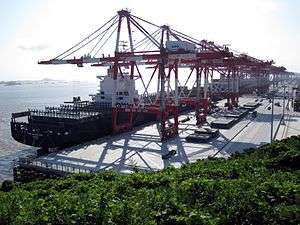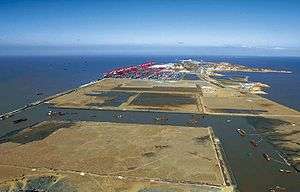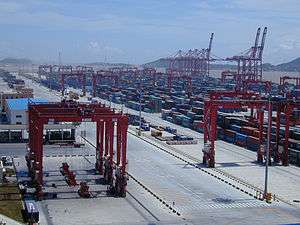Port of Shanghai
| Port of Shanghai 上海港 | |
|---|---|
|
Yangshan Deep-water Port | |
| Location | |
| Country | People's Republic of China |
| Location | Shanghai |
| Coordinates | 30°37′36″N 122°03′54″E / 30.626539°N 122.064958°E |
| Details | |
| Opened | 1842 (As treaty port) |
| Operated by | Shanghai International Port Company Ltd. |
| Owned by | Public |
| Type of harbor | Deep-water seaport/Riverport |
| Statistics | |
| Annual cargo tonnage | 755 million (2014) |
| Annual container volume | 35.285 million TEU (2014) |
|
Website http://www.portshanghai.com.cn | |


The Port of Shanghai (Chinese: 上海港; pinyin: Shànghǎi Gǎng; Wu: Zaanhe Kaon), located in the vicinity of Shanghai, comprises a deep-sea port and a river port.
In 2010, Shanghai port overtook the Port of Singapore to become the world's busiest container port. Shanghai's port handled 29.05 million TEUs, whereas Singapore's was a half million TEU's behind.[1][2]
In 2014, Shanghai port set a historic record by handling over 35 million TEUs.[3]
Geography
The Port of Shanghai faces the East China Sea to the east, and Hangzhou Bay to the south. It includes the confluences of the Yangtze River, Huangpu River (which enters the Yangtze River), and Qiantang River.
Administration
The Port of Shanghai is managed by Shanghai International Port which superseded the Shanghai Port Authority in 2003.[4] Shanghai International Port Company Limited is a public listed company, of which the Shanghai Municipal Government owns 44.23 percent of the outstanding shares.[4]
History
During the Ming dynasty, what is now the city of Shanghai was a part of Jiangsu Province (with a small part in Zhejiang Province). While Shanghai had become a county seat in the Yuan dynasty, it remained relatively a small town.
Its location at the mouth of the Yangtze River led to its development as coastal trade developed during the reign of the Qianlong Emperor in the Qing dynasty. Gradually, the port of Shanghai surpassed the port of Ningbo and the port of Guangzhou to become the largest port of China at the time.
In 1842, Shanghai became a treaty port, thus developing into an international commercial city. By the early 20th century, it was the largest city in the Far East, and the largest port in the Far East.
In 1949, with the Communist takeover in Shanghai, overseas trade was cut dramatically. The economic policy of the People's Republic had a crippling effect on Shanghai's infrastructure and capital development.
In 1991, the central government allowed Shanghai to initiate economic reform. Since then, the port of Shanghai has developed at an increasing pace. By 2005, the Yangshan deep water port was built on the Yangshan islands, a group of islands in Hangzhou Bay, linked to Shanghai by the Donghai Bridge. This development allowed the port to overcome shallow water conditions in its current location, and to rival another deep-water port, the nearby Ningbo-Zhoushan port.
Harbour zones
The port of Shanghai includes 3 major working zones:
Economy
The Port of Shanghai is a critically important transport hub for the Yangtze River region and the most important gateway for foreign trade. It serves the Yangtze economically developed hinterland of Anhui, Jiangsu, Zhejiang and Henan provinces with its dense population, strong industrial base and developed agricultural sector.[5]
Data
See also
References
- ↑ "Shanghai overtakes S'pore as world's busiest port". Straits Times. 8 January 2011. Retrieved 2011-09-14.
- ↑ "Statistics". www.iaphworldports.org. Retrieved 2015-10-03.
- ↑ 2012年上海港货物吞吐量和集装箱吞吐量均能继续保持世界第一位置. Shanghai Municipal People's Government (in Chinese). 17 January 2013. Retrieved 7 April 2013.
- 1 2 "About SIPG". Shanghai International Port (Group) Co., Ltd. Retrieved 2010-03-20.
- ↑ "About Port of Shanghai". Shanghai International Port (Group) Co., Ltd. Retrieved 2010-03-20.
- ↑ http://www.ship-technology.com/projects/portofshnaghai/ Port of Shanghai, China
- ↑ "Top 15 Largest Seaports of the World". GeoHive. Retrieved 2012-12-18.
External links
Coordinates: 30°37′35″N 122°03′53″E / 30.62639°N 122.06472°E

